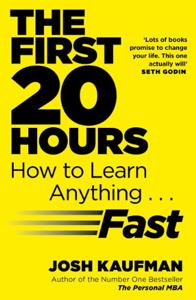
Want to learn the ideas in The First 20 Hours better than ever? Read the world’s #1 book summary of The First 20 Hours by J. Kaufman here.
Read a brief 1-Page Summary or watch video summaries curated by our expert team. Note: this book guide is not affiliated with or endorsed by the publisher or author, and we always encourage you to purchase and read the full book.
Video Summaries of The First 20 Hours
We’ve scoured the Internet for the very best videos on The First 20 Hours, from high-quality videos summaries to interviews or commentary by J. Kaufman.
1-Page Summary of The First 20 Hours
“The 10,000-Hour Rule”
In 2008, Malcolm Gladwell popularized the 10,000-hour rule in his book Outliers: The Story of Success. It’s based on research by Dr. K. Anders Ericsson of Florida State University and states that gaining superior expertise requires at least 10,000 hours of practice–an enormous commitment.
Even the most dedicated musicians and athletes have a limit for how much deliberate practice they can do in one day. Most people would need 10 years to gain world-class mastery of a skill or discipline by practicing only 3.5 hours per day. Considering that most people don’t have enough time to practice more than a couple of hours each week, it’s unrealistic to think you could reach the level of top performers like professional athletes and musicians.
If your goal is to be as good at golf as Tiger Woods, you should start putting in 10,000 hours of focused practice right now. However, if you don’t care about winning a PGA tournament and simply want to become competent enough at golf to have fun and not look foolish, all it takes is 20 concentrated hours of practice.
Your goal is to be good enough at something so that you can enjoy it and do it well. You don’t want to become an expert, but just get a basic understanding of the skill. If you decide to master your new field after putting in 20 hours of effort into learning about it, everything you’ve learned up until then will help you.
The Rapid Skill-Acquisition System
Rapid skill acquisition is a process of breaking down the skill you want to learn into smaller subskills. You then teach yourself these subskills until they’re second nature, eliminate any distractions that might interfere with your learning and practice those skills for 20 hours straight. The steps are simple and straightforward: Decide what you want to learn, figure out how to go about it, set aside time for practicing and then put in the work. Don’t expect instant mastery but if you follow this process diligently over the course of 20 hours, you’ll have basic proficiency in your new skill.
Not Your Traditional Learning Process
There is a difference between learning in school and developing new skills. For example, during your high school Spanish class, the teacher probably gave you many words to learn along with grammar rules and conjugations. You demonstrated that you learned by correctly answering questions on tests about those words, parts of speech and rules. If you studied hard enough, you could get an A for that subject. However, this isn’t how people really learn to speak another language well; it’s more effective if they spend just a few weeks conversing with native speakers than years in a classroom trying to do so.
“10 Principles of Effective Learning”
Although traditional ways of learning have value, teaching yourself can be more effective. When you learn on your own, you’re better able to self-edit and correct mistakes while practicing skills. Ten basic principles are involved in every kind of learning:
“Research the skill and related topics” – Researching is an important part of learning a new skill. Find three books or DVDs or other specific teaching materials on your subject. Quickly review these so you can learn about the subskills that constitute the main skill that interests you.
“Jump into something that seems too difficult.” – Since you want to learn a new skill, expect the material you first come across to be confusing. This confusion is good and will push you to learn more about it. As you gain understanding, any confusing material will become clear.
“Mental models and metaphors are the most basic units of learning.” Mental models set up patterns that show up repeatedly in your life. For example, if you want to learn how to kayak, imagine what would happen if you flipped over your kayak while white-water rafting. That will help you figure out how to get back on top of it again so that you don’t drown or get injured.






